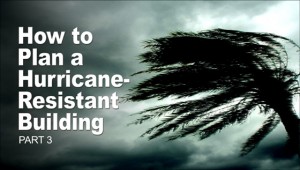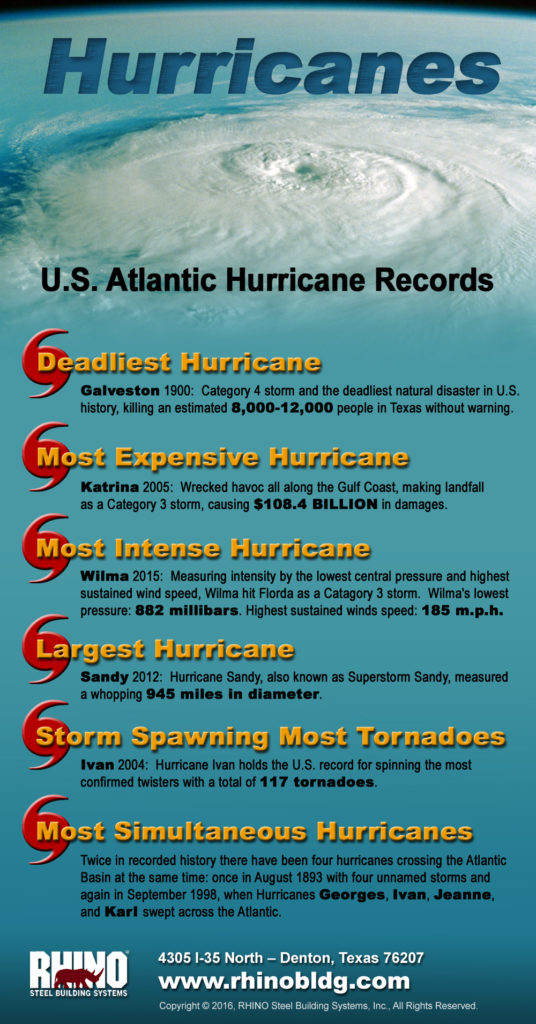Five Ways to Design a Structure in Hurricane-Prone Areas
Hurricane-resistant construction starts in the design phase. While no structure system can promise to be 100% damage-proof in severe cyclones, there are several ways to decrease the risk.
Tropical storms and hurricanes inflict destruction several ways:
- High-velocity straight-line winds
- Tornadoes spawned by the storm system
- Flooding caused by downpours and storm surges
 Avoiding flood damage depends more upon location than design. Consequently, we will focus on structural design methods to maximize hurricane resistance.
Avoiding flood damage depends more upon location than design. Consequently, we will focus on structural design methods to maximize hurricane resistance.
Building to Defeat Wind Damage
Straight-line wind damage compromises the structural integrity of a building when it punches through the building envelope. Any opening or design feature that allows wind to break through to the inside of the structure invites disaster in a hurricane.
Here are five ways to design a hurricane-resistant building that defeats ferocious winds:
1. SHAPE
The lower the profile of the structure, the better it evades hurricane-force winds. The higher the structure, the more likely fierce winds will inflict damage. A one-story building withstands the wind pressure best.
Lower sloped rooflines reduce wind shear. Consider limiting the roof pitch to less than 6/12. Hip roofs deflect wind better than gable roofs.
Metal roofs typically stand up better than shingled roofs in high-wind conditions. Standing seam metal roofs provide the best protection.
The deeper the roof overhang of a building, the greater the lifting force of strong winds on that structure. The most wind-resistant buildings have no overhang at the eave at all, as in most prefabricated steel buildings.
2. FRAMING
 Hurricane resistant buildings begin with strong structural “bones,” the framing of the building.
Hurricane resistant buildings begin with strong structural “bones,” the framing of the building.
There are two reasons we believe pre-engineered steel framing provides the best protection from wind damage.
First, steel boasts the strongest strength-to-weight ratio of any building material.
Secondly, the framing connections in pre-engineered steel buildings resist the lifting forces of wind far better than wood-framed buildings and other structures.
The lifting power of intense winds causes the nails used in wood trusses to pull out and separate from the walls. If the pressure exerts enough force, the wood-framed roof lifts and flies off the structure. Without the roof to hold the structure together, the walls collapse.
Commercial-grade primary steel building components attach with heavy-duty steel bolts and nuts. These fasteners create far stronger connections for hurricane resistant buildings than the nails and staple used in typical wood construction.
3. SKIN
Hurricane-force winds not only rip at a structure, they also shred trees, signs, cars, and other objects. Pieces of demolished buildings, trees, and other items become dangerous projectiles. Howling winds hurl wood studs, tree branches, signs, car parts, and more through the air. Hurricane gales hurl debris into other structures with incredible force.
Texas Tech University studied the effects of wind-blown debris on different types of construction. Building a “cannon” that hurled 2” x 4” wood studs at high velocities into various types of exterior walls, they concluded brick was the most impact-resistant exterior material.
(Fortunately, pre-engineered steel buildings and RHINO hurricane resistant buildings may be finished in any exterior building material, including brick.)
4. OPENINGS
As we discussed earlier, wind penetrating the building envelope marks the beginning structural failure. Designing a structure with fewer openings increases resistance to wind damage.
5. WINDOWS and DOORS
Of course, building applications do require doors and windows for both aesthetics and function. The trick is to invest in impact-resistant doors and windows on your hurricane resistant buildings.
The impact-resistant glass in wind rated windows can shatter if struck with enough force. However, the glass does not break into dangerous shards, slicing through the interior. Impact resistant glass stays in place when fractured.
Installing hurricane shutters provides even more protection.
Exterior doors on hurricane resistant buildings must also be designed to stand up to high-velocity winds in hurricane-prone areas. Wind-rated doors are designed to endure both hurricane-force wind pressure and the impact of wind-borne projectiles.
Proper installation of impact-resistant doors is critical. For maximum protection, all entry doors should open outwards, rather than inwards.
The smaller the overhead door, the greater its resistance to wind. For example, two single-car garage doors on a home are preferable to one double-car door.
Most hurricane-prone areas require wind-rated overhead doors. However, if safety is your concern, you can choose overhead doors for your hurricane resistant building with wind ratings even higher than the minimum required by local codes.
Build safe. Build strong. Build RHINO.
RHINO prefabricated metal building systems meet the challenges of the hurricane and typhoon-prone areas.
RHINO designs structures with wind loads of 170 m.p.h. or more. Our hurricane-proof buildings will meet or exceed every present-day building code— guaranteed for the LIFETIME of the structure.
Wind-rated and insulated overhead doors can be shipped with the RHINO building order to any job site in North America.
Phone RHINO now at 940.383.9566 for more details on hurricane-resistant steel buildings.
Also see Part 1 and Part 2 of this RHINO series on hurricanes.
